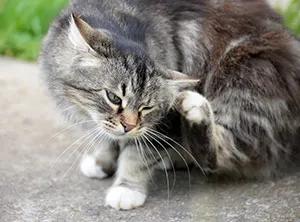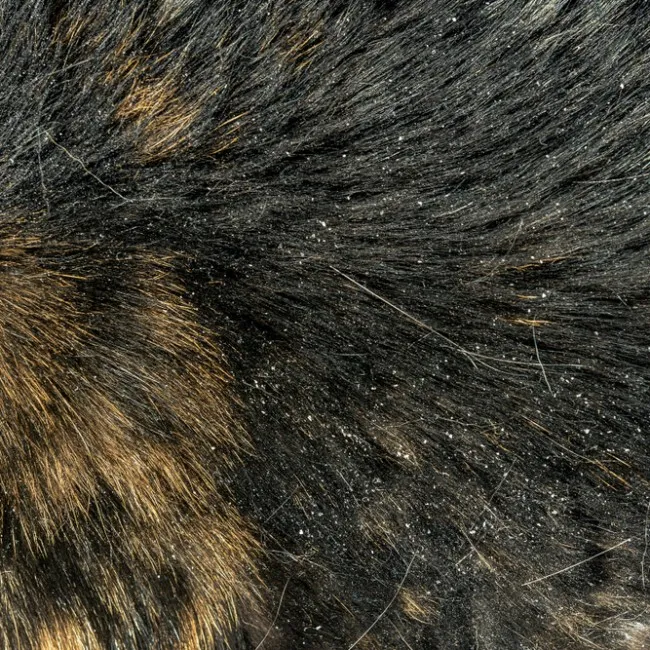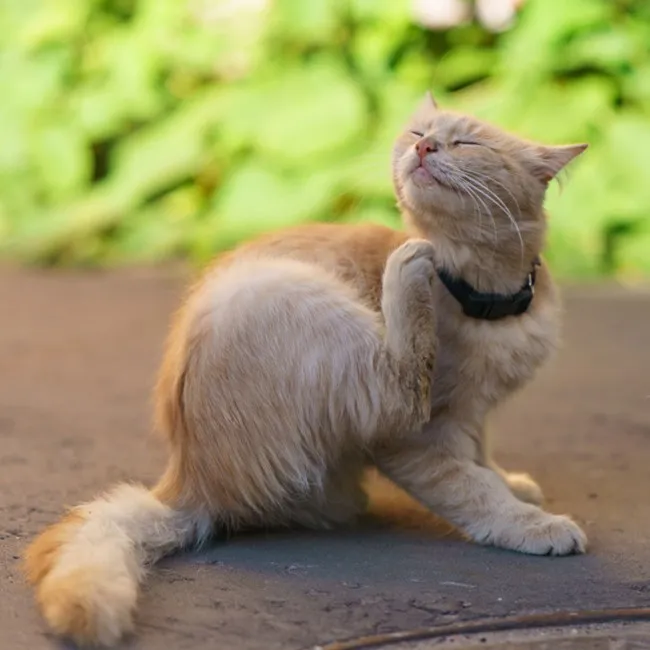10 Common Skin Problems in Cats
Have you noticed an issue on your cat’s skin and coat? Then they may have some sort of cat skin condition. Your felines skin goes through a lot, and as a result, it can be the first place to notice any potential health issues. There are also a plethora of cat skin diseases out there, each with their own signs and symptoms. But how do you know if they have an issue? And how can you tell which one they might have?

What are cat skin conditions?
Just like us, it’s not that unusual for your cat to have the occasional scratch or graze on their skin. But when that scratch becomes constant or you notice bald patches or small parasites, then they could be suffering from a number of different cat skin problems. As a loving pet owner you want to do something, but we’re not all cat experts! To help you understand some more about the different cat skin conditions out there and how to help, here are 10 of the most common:
1. Allergies

Cat skin allergies can be an extremely common issue and are usually grouped into 3 different types: food, environment and skin. Any one of these allergies can result in a reaction on your cat’s skin, even if they’re allergic to eating certain foods. Cat skin irritation is a big sign of some sort of allergy, as well as a rash on contact with the allergen and hives. Scabs on cats can also appear due to persistently itching and scratching at an allergic reaction, so it’s important that you try to avoid the allergen as much as possible in addition to strengthening their natural immunity from within. You can even try putting them on a special hypoallergenic diet.
2. Eczema
Known by many official and informal terms including feline miliary dermatitis, feline eczema and scabby cat disease, cat eczema is a common skin issue where they develop patches of dry and crusty skin that can also develop into a raised red rash. Eczema in cats can be caused by a number of different things including bacteria, parasites, fungi and an allergic reaction. A big sign of eczema is also an irritated and itchy cat, so for their sanity, it is best to deal with it as soon as possible! If it goes unnoticed and gets worse, the itching may result in cat scabs on their back, neck and anywhere on their body.
3. Dry skin
Cat dry skin is very common when it comes to listing the different cat skin problems as it is not only an issue in itself, but can also be a sign of one that is more serious. When your cat is suffering with dry skin, it can mean there is something wrong with their overall skin health, so if you notice cat flaky skin or lacklustre fur, then take a look and see what is happening. Dry skin can also cause irritation which leads to scratching and infection. To help, you can add vitamins, minerals and essential fatty acids (such as from fish oils) into their diet, either through their food or supplementation, as these are known to be great for their skin and fur.
4. Dermatitis
Cat dermatitis, also known as atopic dermatitis, is a cat skin condition that occurs when their immune system overreacts to a stimulus, usually some kind of allergen. Symptoms of cat dermatitis include scratching and itching as well as skin that seems red and inflamed. It can happen on any area of your cat’s body but is most common on their paws, feet, groin, face and ears. As cat dermatitis is usually caused by an allergy, you can’t necessarily ‘cure’ it, but there are things you can do to help. This includes strengthening their internal immune system to help their body deal with the allergen better, as well as using calming and natural products on their skin that won’t dry it out or cause further irritation.
5. Fleas & ticks

Pesky parasites such as fleas and ticks are unfortunately very common in our feline friends. Being parasites, this means they live off a host, meaning they need your cat to survive. Signs of fleas and ticks on your cat include them itching and shaking to try and get rid of them in addition to licking or biting at the area. If your cat has a flea allergy, it can also result in redness and more severe symptoms. Constant scratching due to fleas or ticks can also cause a number of other cat skin conditions, such as eczema and hot spots. Another sign of a severe reaction is if you see scabs on your cat’s neck, back or wherever the parasites are living.
6. Mange
Caused by another type of parasite, mites, the cat skin condition of mange can be split into two types: sarcoptic and demodectic. Sarcoptic mange is the highly contagious kind and can cause symptoms including inflammation, sores, cat skin scabs and bald patches as well as severe irritation. Demodectic mange is less contagious and causes less irritation, but the other symptoms are generally the same. The best way to get rid of these pesky parasites is to use a mite treatment for cats. To avoid ear mites it can be useful as a preventative measure to keep their ears clear using a specific cat ear cleaner.
7. Ringworm
Did you know that ringworm in cats is not caused by an actual worm, but by a fungus? The name ringworm actually comes from the ring-like lesions that the fungus causes. In addition to the round red areas, you may also find red and inflamed and even bald patches. Cat itchy skin is also a big indicator of the potential ringworm fungus. Your feline friend can get ringworm through close contact with another cat with the issue, which is why cat’s that spend a lot of time close together can often all get the fungus at once. You can help get rid of ringworm by using antifungal shampoos or treatments.
8. Yeast infections
As the name suggests, this particular cat skin infection is caused by an abnormal growth of yeast, usually around your cat’s paws or ears. Symptoms of a yeast infection in cats include chewing or pawing at the area, irritation, greasy or discoloured skin and an unpleasant smell. If your cat has a yeast infection, there are many specific treatments available to help. You can also take action to help prevent the infection from returning by keeping their skin clean and healthy as well as regularly washing their paws and using a cat-friendly ear cleaner to remove any earwax, dirt or debris buildup.
9. Seborrhea
Possibly less well known of the cat skin conditions, seborrhea causes dandruff and greasy skin in your cat. Unfortunately, seborrhea is most commonly caused by genetics, so in this case, it is difficult to prevent and can, in theory, last a lifetime. They can, however, also be caused by hormonal issues or allergies. Although it can be harder to totally prevent than other cat skin problems, there are some steps you can take to help your feline-friend. This includes regular grooming and washing of your cat’s skin to keep grease and dandruff at bay, as well as using specific cat shampoos that work for this skin type.
10. Hot Spots

Also known by the official name Moist Dermatitis, hot spots in cats are patches of red and inflamed cat skin sores that feel hot to the touch. These can be anywhere on your cat’s body but are commonly found on the chest, hips or head. The causes of hot spots in cats can vary, but are usually from an infection, a flea bite reaction or excessive licking or chewing at that area of the skin. Hot spot sores on cats can also be irritable, so you need to make sure your cat doesn’t scratch the area as that can make it worse. To help deal with this cat skin condition, you can use a natural hot spot spray and make sure their skin is kelp clean and dry.
How to care for your cat’s skin?

If your furry friend is suffering from a cat skin condition, there are a number of specific treatments and remedies to deal with it. There are also a variety of cat skin problem home remedies that you can try before resulting to taking them to the vets. This can be things like using an apple cider vinegar solution as a cat itchy skin home remedy or by giving your cat a natural supplement. The best supplements for your cat’s skin include ingredients such as vitamins, minerals and essential fatty acids as these help to keep their skin healthy. These can be found in fish oil pills such as cod liver, salmon and krill oil supplements. Just make sure when choosing a supplement that you choose on that is made from natural ingredients and that is tailored to the specific needs of your cat in order to give them the best.
























